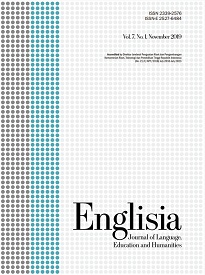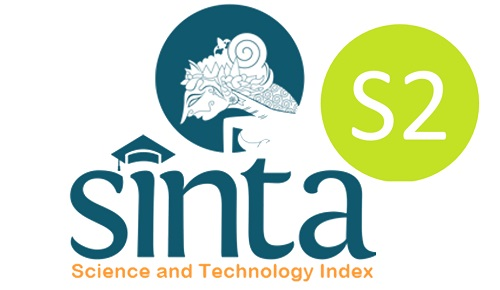Using reading journals to identify moral values in the extensive reading books
DOI:
https://doi.org/10.22373/ej.v11i2.22129Keywords:
Extensive reading, Reading journals, Moral valuesAbstract
With the mushrooming popularity of extensive reading in language classrooms, teachers might be unaware that students are not only gaining linguistic inputs from their reading but also those related to non-linguistic ones, such as moral values. Frankly speaking, some values may suit their culture, but others may not. This research then aimed to investigate these non-linguistic inputs the students obtained when participating in the Extensive Reading ER program. This is important amid the domination of Western culture in stories that students mostly use. This research tried to identify the types of moral values students attained after attending a one-semester ER program. Also, it questioned if these values fit with the culture and place where they lived. Using the diary method, this research collected students’ post-reading journals over one academic semester. The journals should be filled in every time the students finish reading. Involving 30 students as participants, the research generated 397 entries, 13 on average. The data were analyzed by classifying the students’ responses into five principles of moral values proposed by the Indonesian Ministry of Education and Culture. This research found that most moral values in the ER program aligned with those in Indonesia, despite a few differences. It also provided two most frequent moral values that were surprisingly close to Western culture. This research shared some interesting discussion, including the possible reasons why these two categories have a strong domination, outperforming other categories. Finally, the research also provides important notes regarding what teachers should do and key suggestions for future research.
Downloads
References
Aka, N. (2019). Reading performance of Japanese High School Llearners Ffollowing Aa Oone-yYear Eextensive Rreading Pprogram. Reading in a Foreign Language, 31(1), 1-18.
Anandari, C. L., & Iswandari, Y. A. (2019). Extensive reading in Indonesian schools: A successful story. Teflin Journal, 30(2), 137-152.
Azizi, M., Tkácová, H., Pavlíková, M., & Jenisová, Z. (2020). Extensive Reading and the Writing Ability of EFL Learners: The Effect of Group Work. European Journal of Contemporary Education, 9(4), 726-739.
Chang, A. C., & Renandya, W. A. (2017). Current practice of extensive reading in Asia: Teachers’ perceptions. The Reading Matrix: An International Online Journal, 17(1), 40-58.
Damayanti, L. S., Nitiasih, P. K., & Santosa, M. H. (2018). Character-based eExtensive English rReading mMaterials dDevelopment of English tTeachers and sStudents of sSecondary eEducation in Bali: Needs aAnalysis. In Santosa, M.H., Paramarta, I.M.S., Adnyani, N.L.P., Utami, I.G.A.L.P. (Eds.) Proceedings 4th International Conference On English Across Culture (pp.178-186). Undiksha Press. http://fbs.undiksha.ac.id/wp-content/uploads/2022/03/PROCEEDING-ICEAC-2018.pdf
Day, R. (2015). Extending extensive reading. Reading in a Foreign Language, 27(2), 294-301.
Day, R. R., & Bamford, J. (1998). Extensive rReading in the sSecond lLanguage cClassroom. Cambridge: Cambridge University Press.
Friedman, D. A. (2017). How to cCollect and aAnalyze qQualitative dData. In Research Methods in Second Language Acquisition (pp.180-200). Sussex: Wiley-Blackwell.
Galloway, N., & Rose, H. (2014). Using listening journals to raise awareness of Global Englishes in ELT. ELT journal, 68(4), 386-396. https://doi.org/10.1093/elt/ccu021
Goto, T. (2021). The Eeffect of 20-minute Eextensive Rreading aActivities on TOEIC IP Scores. The Reading Matrix: An International Online Journal, 21(2). 145-152.
Halimah, L., Arifin, R. R., Yuliariatiningsih, M. S., Abdillah, F., & Sutini, A. (2020). Storytelling through “Wayang Golek” puppet show: Practical ways in incorporating character education in early childhood. Cogent Education, 7(1), 1-12.
Krashen, S. (1982). Principles and practice in second language acquisition. Sydney: Pergamon Press.
Krashen, S., & Mason, B. (2020). The Optimal input hypothesis: Not all comprehensible input is of equal value. CATESOL Newsletter, May, 1-2. https://www.researchgate.net/publication/341503469_The_Optimal_Input_Hypothesis_Not_A ll_Comprehensible_Input_is_of_Equal_Value
Kusnoto, Y. (2018). Internalisasi nilai-nilai pendidikan karakter pada satuan pendidikan. Sosial Horizon: Jurnal Pendidikan Sosial, 4(2), 247-256.
Liu, X. (2021). Exploration and pPractice of iIntegrating mMoral eEducation into cCollege English rReading &Wwriting cCourse. In 2021 4th International Conference on Humanities Education and Social Sciences (ICHESS 2021) (pp. 61-64). Atlantis Press.
Liu, J., & Zhang, J. (2018). The eEffects of eExtensive rReading on English vVocabulary lLearning: A Meta-Analysis. English language teaching, 11(6), 1-15.
Lyutaya, T. (2011). Reading Llogs: Integrating eExtensive rReading with wWriting tTasks. In English Teaching Forum (Vol. 49, No. 1, pp. 26-34). US Department of State. Bureau of Educational and Cultural Affairs, Office of English Language Programs, SA-5, 2200 C Street NW 4th Floor, Washington, DC 20037.
Mason, B. (2019). Guided SSR before self-selected reading. Shitennoji University Bulletin, 67, 445-456.
Mason, B., & Krashen, S. (2019). Hypothesis: A class supplying rich comprehensible input is more effective and efficient than “Immersion.” IBU Journal of Educational Research and Practice, 7, 83-89. https://tinyurl.com/y4zdwmmz
Meniado, J. C. (2021). Extensive reading practices in the Arabian Gulf region. Eurasian Journal of Applied Linguistics, 7(1), 222-239.
Milal, A. D. U., Rohmah, Z., Kusumajanti, W., Basthomi, Y., Sholihah, D. N., & Susilowati, M. (2020). Integrating character education in the English teaching at Iislamic jJunior Hhigh Sschools in Indonesia. TEFLIN Journal, 31(1), 88-107. http://dx.doi.org/10.15639/teflinjournal.v31i1/88-107
Nadhif, A. (2017). Representation of rReligious and mMoral vValues in the English tTextbook for Indonesian Junior High School: A CDA iInvestigation. Kodifikasia, 11(1), 79-104. http://dx.doi.org/10.21154/kodifikasia.v11i1.1148
O’Connor, C., & Joffe, H. (2020). Intercoder reliability in qualitative research: debates and practical guidelines. International journal of qualitative methods, 19,1-13.
Pashmforoosh, R., & Babaii, E. (2015). Whose culture and how far? Culture presentation in current business English textbook series. Journal of Teaching in International Business, 26(3), 216-236.
Renandya, W. A., Hidayati, M., & Ivone, F. M. (2021). Extensive reading: Top ten implementation issues. JACET Journal.
Renandya, W. A., & Jacobs, G. M. (2016). Extensive rReading and lListening in the L2 cClassroom. In English language teaching today (pp. 97-110). Singapore: Springer
Renandya, W. A., Jacobs, G. M., Krashen, S., & Min, C. O. H. (2019). The power of reading: Case histories of second and foreign language readers. Language and Language Teaching, 8(1), 10-14.
Revesz, A. (2012). Coding sSecond lLanguage dData vValidly and rReliably. In . In Research mMethods in Ssecond lLanguage aAcquisition (pp.203-221). Sussex: Wiley-Blackwell.
Rose, H. (2020). The routledge handbook of research methods in applied linguistics. London: Routledge.
Shelton-Strong, S. J., & Mynard, J. (2021). Promoting positive feelings and motivation for language learning: the role of a confidence-building diary. Innovation in Language Learning and Teaching, 15(5), 458-472. https://doi.org/10.1080/17501229.2020.1825445
Shin, J., Eslami, Z. R., & Chen, W. C. (2011). Presentation of local and international culture in current international English-language teaching textbooks. Language, Culture and Curriculum, 24(3), 253-268.
Sofa, E. M. (2020). Moral values in Western and Indonesian stories: a research on the stories for the ninth grade of jJunior hHigh Sschool. Journal of English Education and Teaching, 4(3), 449-465. https://ejournal.unib.ac.id/JEET/article/view/11779
Syed, H., & Kuzborska, I. (2020). Dynamics of factors underlying willingness to communicate in a second language. The language learning journal, 48(4), 481-500. https://doi.org/10.1080/09571736.2018.1435709
Qoyyimah, U. (2016). Inculcating character education through EFL teaching in Indonesian state schools. Pedagogies: An International Journal, 11(2), 109-126. http://dx.doi.org/10.1080/1554480X.2016.1165618
Yang, Y. H., Chu, H. C., & Tseng, W. T. (2021). Text difficulty in extensive reading: Reading comprehension and reading motivation. Reading in a Foreign Language, 33(1), 78-102.
Yuen, K. M. (2011). The representation of foreign cultures in English textbooks. ELT journal, 65(4), 458-466.
Downloads
Published
Issue
Section
License
Proposed Policy for Journals That Offer Open Access
Authors who publish with Englisia journal agree to the following terms:
- Authors retain copyright and grant the journal right of first publication with the work simultaneously licensed under a Creative Commons Attribution License that allows others to share the work with an acknowledgement of the work's authorship and initial publication in this journal.
- Authors are able to enter into separate, additional contractual arrangements for the non-exclusive distribution of the journal's published version of the work (e.g., post it to an institutional repository or publish it in a book), with an acknowledgement of its initial publication in this journal.
- Authors are permitted and encouraged to post their work online (e.g., in institutional repositories or on their website) prior to and during the submission process, as it can lead to productive exchanges, as well as earlier and greater citation of published work (See The Effect of Open Access).









